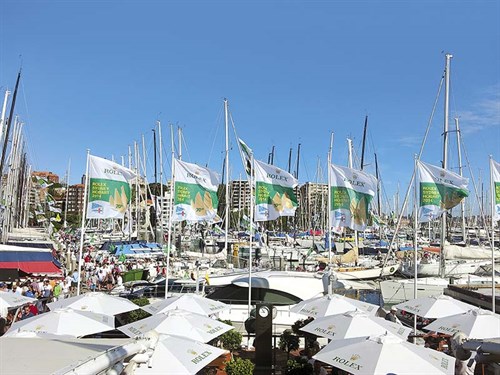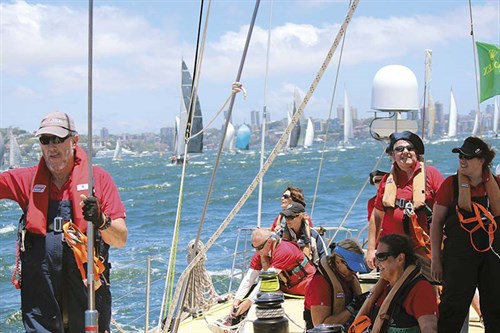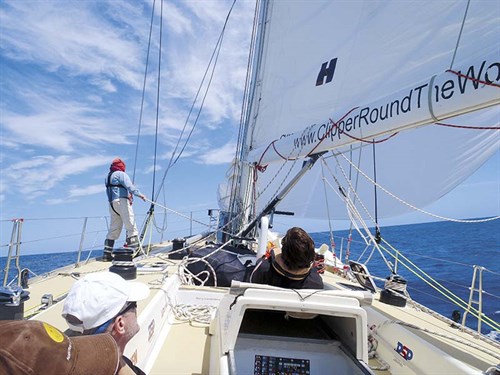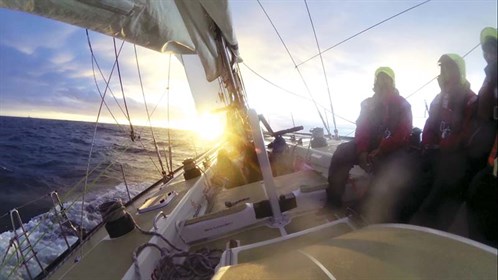No matter what level of sailing experience you possess, Clipper Ventures will (for a price) send you around the world or take on the Rolex Sydney Hobart yacht race.
Powering to the start line with 18 crew bustling around the decks of the 68-foot Clipper Ventures 10, I briefly contemplated what lay ahead in this 70th Rolex Sydney Hobart Race.
Firstly, a harbour strewn with 117 race yachts and a starboard tack among them as we broad-reached to the middle of the three start lines, while up ahead loomed the black hull of the super maxi Comanche that glinted in the bright sunlight before disappearing behind the grey sails of race favourite Wild Oats XI.
In a mere four minutes Comanche would be out of Sydney Heads pursued by Oats, while we shouted our way through the mid-fleet throng with English skipper Piers Dudin shouting “Starboard!” to the armada of smaller yachts that jostled us.
SYDNEY TO HOBART
Overhead, sky writing declared the number 70 as a reminder of the editions of this great 628nm race south to Tasmania and the old seafaring town of Hobart, a favourite port for the clipper ships sailing the Great Circle Route through the Southern Ocean.
Now our modern Clipper Ventures ship was on its way there, with an expected time of four days if we survived the first night’s southerly buster that slammed into us earlier as the crowds on South Head waved their goodbyes.
With a reef mainsail, staysail and yankee foresail bar tight, we bounced our way paast Bondi Beach as the crew held on tightly to the rail. With four circumnavigations and more than 140,000 miles under her GRP hull, Clipper Ventures 10 is a proven ocean racing yacht and definitely my preferred ride in the fleet as the heavy hull sedately thuds into the oncoming two-metre swells.
MULTINATIONAL CREW
Our multinational crew of mostly experienced offshore Clipper-trained sailors had been practising hard for the two weeks prior to the Boxing Day start, so were well acquainted with the 10-year-old CV10. Being a newcomer to the boat, this was something I appreciated as they showed me the ropes during the first afternoon, while we bashed our way down the New South Wales coast. Around us the wind steadily rose to about 30kts and grey clouds scudded past as the fleet spread out, some choosing to tack inshore and others stood on in search of a push from the famed East Australian Current.
On the helm in the late afternoon I wrestled with the bucking wheel as the bow of the CV10 cut through the top of swells, spinning it down to ease the landing of the 30-ton hull in the troughs. Exhilarating steering, something most helmsmen thrive on but with my four-hour watch ending, it was time to go below to my pipecot and pull the lee cloth high to prevent me being bucked out amid the sail bags.
As the last to join the crew, inevitably I had the worst berth, right in the bow. The rise and fall slammed me against the bunk above, while my feet banged against the forward bulkhead. Welcome to a bumpy night of ocean racing, I wryly contemplated as my head rested on my kitbag in order to bring on some fitful sleep while my stomach wrestled to hold in the night’s dinner of spaghetti Bolognese.
It seemed like a blink of an eyelid before the calloused hand of sailing master Wayne Reed was nudging me awake for the night watch. With headtorch on I scrambled to clamber into a warm layer followed by oilskins, lifejacket and harness before grimly climbing the heaving ladder to reach the cockpit where my three other watch-mates braced themselves on the steeply heeled deck.
Ahead of us the dark silhouettes on the horizon turned out to be coal ships, notifying us that we were off Wollongong, 50 miles south of Sydney. As we sped past at 10kts my eyes stung with constant sea spray that clouded the compass reading of 180 degrees for our rhumb line course, while I willed daylight’s arrival to cheer us all up.
Morning showed the low-lying coast to starboard and another clear sunlight day to enjoy. “There’s a shark,” crewman Alex from Wales called out as we passed the flopping fin of what turned out to be a sunfish. Growing to nearly the size of a small car they are hazardous and in fact ended the race of the 100-foot super maxi Perpetual Loyal that very day, along with about six other yachts that had been badly shaken during the night.
Our own problem though was looming as a high-pressure system hovered over to suck the wind pressure, leaving us lolling for hours as lighter-weight competitors sneaked inshore and offshore of us to snatch what zephyrs there were. These included the Sailors with Disabilities yacht that stole inshore and over the horizon where mares’ tales in the afternoon sky foretold yet another change coming.
To wile away the time a quiet lunch of quiche and salad was handed up on deck and the news from the scheduled call-up showed us now firmly at the back half of the 109-boat fleet. A glaring sun drove us to smother ourselves in sun cream and strip off the damp oilskins before the reefs were shaken out of the mainsail and the heavy yankee headsail changed up to the largest, the number 1.
Many of our crew had flown from Europe for this race and were enjoying the warm sailing and their first Rolex Sydney Hobart. Pamela from Aberdeen had swapped shifts with a co-worker to escape her stint on a North Sea oil rig for a few weeks, while young mother Veronica had merely hopped on a plane from Auckland, but both were Clipper veterans with plenty of offshore experience and revelling in their first Sydney Hobart.
They would need all this experience and training in the ensuing 24 hours as the northerly wind filled in and spinnaker work commenced. It began with the hoisting of the biggest spinnaker, our number 1 asymmetric. Our boat is a training yacht for the crews going on the new Clipper 70s, so had been changed to asymmetric spinnakers and flew these from a small retrofitted bowsprit. Unlike other competitors our Clipper 68 was built for ocean racing and all equipment was very heavy and required plenty of crew to handle most jobs, including the heaving of the sailbags from our crew quarters to the deck.
BASS STRAIT KITE RUN
Down at the navigation station skipper Piers made the obligatory High Frequency radio call at Green Cape to say we were proceeding across Bass Strait. As the wind rose to above 15kts, we reduced sail to the smaller spinnaker, which meant some of us had to go below decks for 30 minutes to retie the big kite with woollen string and repack it ready for its next deployment.
Sweating and tired we gasped our way through the work as CV 10 sped into the night but were cheered by the off-watch crew cooking roast pork and savoury rice for dinner with Christmas cake for dessert. Back on the helm again, a clear sky showed all the stars allowing me to steer towards the Southern Cross as shoreward, a half moon rose to lighten up the swells, while brilliant phosphorescent trails silhouetted the paths of dolphins that darted across our bow waves. “Brilliant,” declared health worker Sharon who’d flown down from Queensland to become a mainstay in the pit where all the halyards were hoisted from. But there wasn’t much time for contemplation as the on-watch of eight crew rotated between jobs.
For me, a really great part of the Clipper experience is that everyone is trained to do every job, including steering, even though some junior crew can decline should they feel not quite ready. Controlling the spinnaker can be one of the more physical and stressful jobs, so as the wind rose and we sped across Bass Strait, crew were rotated every 15 minutes from their stance on the foredeck holding the heavy spinnaker sheet.
“I found the Clipper training fairly intense but worthwhile,” explained Melbourne doctor Stephen who was one of the few not to have done a Clipper round-the-world leg, instead enjoying cruising his own S&S 34. Meantime, the Sunday afternoon in Hobart was being enlivened with the arrival of winner Wild Oats XI after a mere two days and two hours at sea.
40kts AT TASMAN ISLAND
But as on my previous Rolex Sydney Hobart the weather had more challenges in store for us as we passed Maria Island midway down the Tasmanian coast. Our PredictWind software was showing 30 to 40kt westerly winds for our approach to the fabled Storm Bay, the 40 miles of water that leads into Hobart. So as Sunday night turned into Monday and the wind rose, we doused our spinnaker and ran goose-winged with the yankee headsail poled out on the long alloy spinnaker pole that required four crew to move.
Following seas rose to above two metres as our latitude fell to 41°⁰South, prompting Alex to declare that it was similar to his Southern Ocean Clipper experience. As the towering cliffs of Tasman Island became shrouded, we braced for the inevitable wind blast. I laboured with novice Australian sailor Jay to pull the orange storm trysail forward, then hank it onto the forestay as the wind shrieked to 40kts before clambering below to do my turn on the washing-up. The galley was in chaos, outside a huge blast spun the boat causing the boiling kettle to jump out of its fiddles and fly across the galley, while dishes flew like confetti and I cursed loudly at the weather Gods.
But worse was to follow for others. Rounding into Storm Bay a small Cessna aeroplane flew past at mast height heading north to where another backmarker yacht Mistraal laboured. This turned out to be the last flight and moments for the 28yo pilot and 61yo Hobart photographer as, unbeknown to us, it fatally plunged into the sea.
We meanwhile bashed shoreward across the inky black night in Storm Bay before our friend the moon rose to again shine on us as we passed the famous Tin Pot light and the finish line on the sheltered River Derwent.
SYDNEY TO HOBART CLIPPER 2015/16
Clipper Ventures Sydney office is recruiting for this year’s Rolex Sydney Hobart Race and the famous 40,000-mile round-the-world race. The company’s new Clipper 70 yachts will also call in at Sydney next December, so if you want be part of this 11-month global race, contact Clipper Ventures Australia managing director Kirsty Whyte, phone +61 2 9363 2020 or email: australia@clipper-ventures.com
See the full version of this review in Trade-A-Boat #251, March / April 2015. Why not subscribe today?
Photography: Kevin Green & RSHYR










